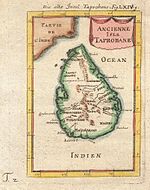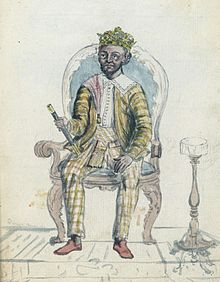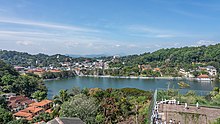Kandyan period
| History of Sri Lanka | ||||||||||||||
|---|---|---|---|---|---|---|---|---|---|---|---|---|---|---|
 | ||||||||||||||
| Chronicles | ||||||||||||||
|
||||||||||||||
| Periods | ||||||||||||||
|
||||||||||||||
| By Topic | ||||||||||||||
|
||||||||||||||
The Kandyan period covers the history of
Overview
Periodization of Sri Lanka history:
| Dates | Period | Period | Span (years) | Subperiod | Span (years) | Main government |
|---|---|---|---|---|---|---|
| 300,000 BP–~1000 BC | Prehistoric Sri Lanka | Stone Age
|
– | 300,000 | Unknown | |
| Bronze Age | – | |||||
| ~1000 BC–543 BC | Iron Age
|
– | 457 | |||
| 543 BC–437 BC | Ancient Sri Lanka | Pre-Anuradhapura | – | 106 | Monarchy | |
| 437 BC–463 AD | Anuradhapura | 1454 | Early Anuradhapura
|
900 | ||
| 463–691 | Middle Anuradhapura
|
228 | ||||
| 691–1017 | Post-classical Sri Lanka | Late Anuradhapura
|
326 | |||
| 1017–1070 | Polonnaruwa | 215 | Chola conquest | 53 | ||
| 1055–1232 | 177 | |||||
| 1232–1341 | Transitional | 365 | Dambadeniya
|
109 | ||
| 1341–1412 | Gampola
|
71 | ||||
| 1412–1597 | Early Modern Sri Lanka | Kotte
|
185 | |||
| 1597–1815 | Kandyan | – | 218 | |||
| 1815–1948 | Modern Sri Lanka | British Ceylon | – | 133 | Colonial monarchy | |
| 1948–1972 | Contemporary Sri Lanka | Sri Lanka since 1948 | 76 | Dominion | 24 | Constitutional monarchy |
| 1972–present | Republic | 52 | Unitary semi-presidential constitutional republic |
Background
Senasammata Vikramabahu
Rajasinha II
Kirti Sri Rajasinha

Sri Rajadhi Rajasinha

Sri
Sri Vickrama Rajasinha

He also donated more lands to Dalada Maligawa and the King gave high prominence to Dalada Perahara. Sri Vickrama Rajasinha embraced Buddhism and did sacrifices to the Tooth Relic of Buddha.[4] Several ministers under the king conspired against him. They actively provided intelligence to the British Empire. On 14 February 1815, a British division entered Kandy and took possession of the city. Several of the ministers signed the Kandyan Convention which was an agreement for the deposition of Sri Vikrama Rajasinha and ceding of the Kingdom's territory to British rule. There were twelve signatories to the Kandyan Convention signed in the following languages: four signed in Tamil, three, in Tamil and Sinhalese and four, in Sinhalese. This act effectively ended the Sovereignty of the Kandy Nayakar Dynasty.[4] The king was captured by the British and send to Madurai as a prisoner. The signing of the convention is known as the greatest act of traitorship in Sri Lankan history.[4]
Great Rebellion of 1817–18
The Great Rebellion of 1817–18 took place in the former Kandyan Kingdom after two years of it being captured by the British. The purpose of the rebellion was to make a blood relative of the Nayak kings named Doraisami the ruler again.[5] Keppetipola Disawe was sent initially by the British government to stop the uprising but ended up joining the rebellion as its leader and is celebrated for his actions even today in Sri Lanka. The rebels captured Matale and Kandy before Keppetipola fell ill and was captured and beheaded by the British. His skull was abnormal — as it was wider than usual — and was sent to Britain for testing. It was returned to Sri Lanka after independence, and now rests in the Kandyan Museum. The rebellion failed due to a number of reasons. It was not well planned by the leaders. The areas controlled by some Chiefs who helped the British provided easy transport routes for British supplies. Doraisami who was said to have a claim to the Sinhalese throne was found not to have any relation.[6][7][8][9][10]
See also
References
- ^ John Pike. "Sri Lanka - Kingdom of Kandy - 1476-1818". globalsecurity.org. Retrieved 22 December 2018.
- ^ "History of the Kandyan Kingdom - Central Provincial Council - Sri Lanka". cp.gov.lk. Retrieved 22 December 2018.
- ^ "We still celebrate the bravery of King Rajasinghe II - Daily Mirror - Sri Lanka Latest Breaking News and Headlines". dailymirror.lk. Retrieved 22 December 2018.
- ^ a b c d "The History of the Kingdom of Kandy - The Royal Family of Jaffna". jaffnaroyalfamily.org. Retrieved 22 December 2018.
- ^ "Sinhalay's fearless warrior". ceylon-ananda.com. Retrieved 22 December 2018.
- ^ Keppetipola and the Uva Rebellion Virtual Library Sri Lanka. Retrieved 1 October 2007.
- ^ "Uva Wellassa rebellion - 1817 -1818". Retrieved 23 October 2014.
- ^ "Wellassa riots in 1818". southasianmedia.net. Archived from the original on 7 November 2017. Retrieved 22 December 2018.
- ^ "Torture tree of the British Army". Retrieved 23 October 2014.
- ^ "1818 Uva Wellassa rebellion". srilankatoday.com. Retrieved 22 December 2018.[permanent dead link]
